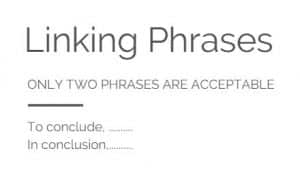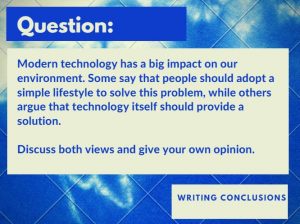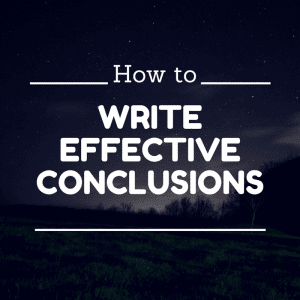This post will help you write effective conclusions for IELTS writing task 2 essay questions. It is suitable for both General Training and Academic candidates.
The conclusion is the easiest paragraph to write because, in many ways, you are just using ideas you have already mentioned in your introduction and main body paragraphs. However, this is the last thing the examiner will read, and it is, therefore, crucial that you finish strongly.
You will probably not have much time remaining when you are writing your conclusion, so you must practice them and learn how to write them quickly. I will show you how below.
IELTS Conclusion Quick Tips
- Never write any new ideas in your conclusion. A conclusion should always restate your ideas in the rest of the essay. New ideas should be in the main body and not in the conclusion.
- Make sure you answer the question in the conclusion. The conclusion should state your thoughts about the question and clarify your feelings about the issue.
- Vary your language. Just because you are restating your ideas in the rest of your essay doesn’t mean you use the same language. Instead, you show the examiner you have a wide vocabulary by paraphrasing.
- Don’t try to include everything. You are not required to go into detail; you have already done that in your main body paragraphs. Instead, you will summarise your main points.
- Always write one. It isn’t easy to get a good score in task 2 if you haven’t finished your essay with a conclusion. Even if you are running out of time, make sure you write one.
Linking Phrases
First, you should start with a linking phrase, but some are better than others. Here are some examples:
- Finally
- In a nutshell
- In general
- In conclusion
- To conclude
Finally isn’t really suitable because it indicates that you are making a final point and therefore a new idea. Finally belongs in the main body of your essay, not the conclusion.
In a nutshell is too informal, and we should never use it in IELTS conclusions.
In general tells the reader you are going to talk generally about a topic. This is not what we will do in our conclusion, and we should not use it.
In conclusion and to conclude are the only two linking phrases you should use to start your conclusion. They tell the reader exactly what the paragraph is about and are formal. You will only write one conclusion, so pick one and stick with it.
How to Write a Good Conclusion
There are two elements to a good conclusion:
- Summarising the main points of your essay
- Varying your vocabulary by paraphrasing
Luckily we have already stated our main points in the introduction, so all we have to do is look back at the conclusion and paraphrase this.
Let’s look at some examples:
Introduction
It is argued that students should be taught real-life skills, like how to look after money. This essay agrees that they should be part of the curriculum because everyday competencies benefit people later in life, and not being taught how to manage money at an early age can lead to dangerous consequences in adulthood.
I have completed an effective introduction by doing three things:
- Paraphrasing the question
- Stating my opinion
- Outlining what I will talk about in the rest of the essay or in other words, the main points I’m using to support my opinion.
Conclusion
In conclusion, this essay supports the idea that teenagers should be taught functional subjects like financial planning because it helps them in adulthood, and a lack of education related to these topics can have serious consequences.
So all I have done is restate my opinion and included my main supporting points. However, I have not simply copied all the words; I have used synonyms and paraphrasing to vary my language.
Note that I have repeated some words. Paraphrasing does not mean changing every single word. If you cannot think of a way to change every word, feel free to repeat that word. In general, you should try to vary your vocabulary as much as possible, but it is often impossible to change every single word. Better to repeat a word accurately than change it to something wrong.
Here are the paraphrases I used:
This essay supports- This essay agrees
should- ought to
students- teenagers
functional subjects- real-life skills
look after money- financial planning
later in life- in adulthood
Let’s look at another example:
Introduction
Contemporary advances have a serious effect on the planet. While I appreciate that critics may hope that people will shun the latest developments, I believe that technology itself can give us an answer. This essay will first discuss how not using electronics is unfeasible, followed by a discussion of how science is now coming up with ways to reverse global warming and pollution.
This introduction does three basic things:
1. Paraphrases the question
2. States opinion
3. Outlines what the essay will discuss
Conclusion
In conclusion, this essay acknowledges that technological progress jeopardises the planet, but cutting-edge discoveries can halt and even heal this destruction.
Again, all I have done is repeat what I said in the introduction using paraphrasing.
Adding a Prediction or Recommendation to Our Conclusion
We can also add a prediction (what we think will happen) or a recommendation (what we think should happen) to our conclusion.
This is totally optional. I teach students how to write these because it allows them to write something at the end of the essay if they are worried about not making it to 250 words. Only use these if you cannot get over the word count.
Here are my two previous conclusions with one added sentence:
In conclusion, this essay supports the idea that teenagers should be taught functional subjects like financial planning because it helps them in adulthood, and a lack of education related to these topics can have serious consequences. It is recommended that governments make this a compulsory part of the education system.
In conclusion, this essay acknowledges that technological progress jeopardises the planet, but cutting-edge discoveries can halt and even heal this destruction. It is predicted that climate change will be successfully tackled with such inventions.
Next Steps
If you found this article useful and want more help with writing task 2, please visit our task 2 page.








